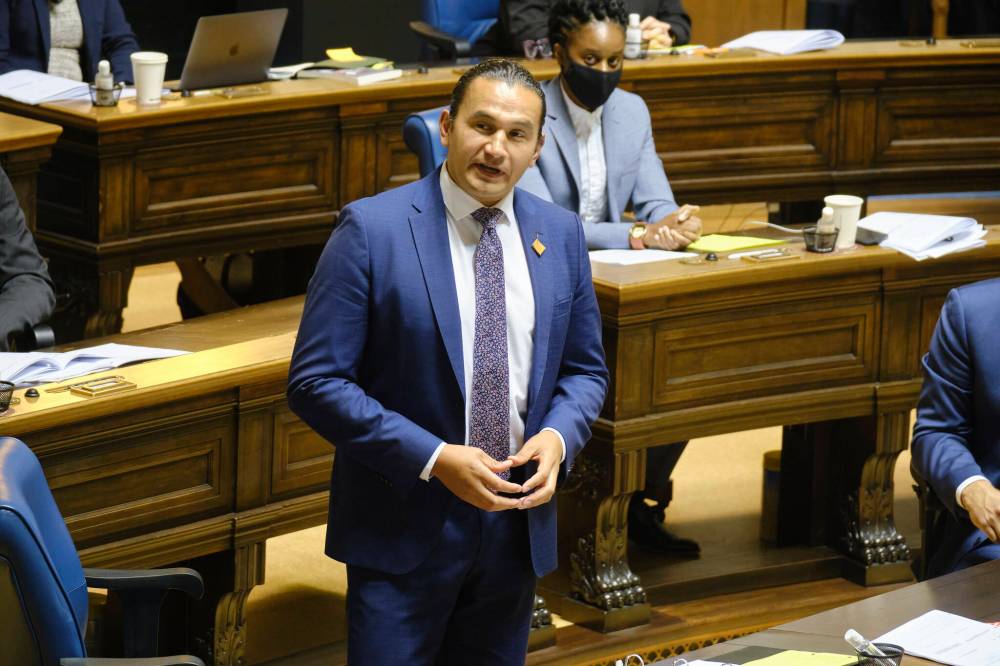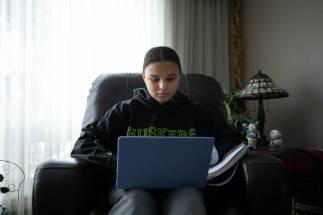Return to remote learning punctuated by countdown to in-person education
Read this article for free:
or
Already have an account? Log in here »
To continue reading, please subscribe:
Monthly Digital Subscription
$0 for the first 4 weeks*
- Enjoy unlimited reading on winnipegfreepress.com
- Read the E-Edition, our digital replica newspaper
- Access News Break, our award-winning app
- Play interactive puzzles
*No charge for 4 weeks then price increases to the regular rate of $19.00 plus GST every four weeks. Offer available to new and qualified returning subscribers only. Cancel any time.
Monthly Digital Subscription
$4.75/week*
- Enjoy unlimited reading on winnipegfreepress.com
- Read the E-Edition, our digital replica newspaper
- Access News Break, our award-winning app
- Play interactive puzzles
*Billed as $19 plus GST every four weeks. Cancel any time.
To continue reading, please subscribe:
Add Free Press access to your Brandon Sun subscription for only an additional
$1 for the first 4 weeks*
*Your next subscription payment will increase by $1.00 and you will be charged $16.99 plus GST for four weeks. After four weeks, your payment will increase to $23.99 plus GST every four weeks.
Read unlimited articles for free today:
or
Already have an account? Log in here »
Hey there, time traveller!
This article was published 10/01/2022 (1433 days ago), so information in it may no longer be current.
Screen time and anxiety levels spiked Monday, as students and teachers logged onto remote school for the first time in 2022 — with a week-long countdown until face-to-face instruction resumes, despite widespread COVID-19 community transmission.
By 3:30 p.m., which is when the school day typically ends at Collège Sturgeon Heights Collegiate in Winnipeg, Ebony Furst had spent about four hours on her smartphone and three hours on her laptop, respectively.
In previous e-learning periods, the Grade 11 student’s screen time has been 10-12 hours daily, given she decompresses via texting friends, playing video games and scrolling on social media in the evenings.
“I actually get a lot of headaches. I’ve noticed that a lot — especially last year, when we were doing online (school). My eyes hurt quite a bit,” said the 16-year-old.

Other side-effects of remote learning for Ebony include a decrease in motivation and increase in irritability; sometimes, the latter occurs because of internet lags, resulting from the fact she and three younger siblings are working on a single Wi-Fi network.
For at least the fourth time since the COVID-19 pandemic began, the majority of elementary students and high schoolers in Winnipeg are doing emergency remote learning this week. Students elsewhere in the province are also getting reacquainted with the delivery model.
No matter their location, they now know what to expect.
Distance learning, for those lucky enough to have a device and reliable internet, involves participating in classroom video calls and doing independent work while navigating home distractions, social isolation and exhaustion from spending so much time staring at a computer screen.
“I actually get a lot of headaches. I’ve noticed that a lot– especially last year, when we were doing online (school). My eyes hurt quite a bit.”
– Ebony Furst
Winnipeg educator Tara McLauchlan said there’s an, “OK, let’s do the thing” attitude among senior years students and teachers this week, because no one is a stranger to e-learning anymore.
At the same time, McLauchlan, who taught remote learners full-time in 2020-21, said distance learning continues to be a catalyst for frustration because it allows for time for quiet self-reflection about everything else going on in the world.
However, it’s important to note learning in any form is occurring during a crisis, said the St. James-based literacy coach: “We have to think of the emotional repercussions (of in-class learning), too.”
Families worthy of remote-learning support: NDP

Posted:
Families forced to rearrange daily routines, find temporary child care and pay out of pocket for supplies while schools are in remote learning deserve government compensation, the official Opposition says.
Top of mind for McLauchlan is how such an in-person return can actually be done in a safe way, if many schools are crowded and two metres of physical distancing at all times is simply not possible.
Manitoba Premier Heather Stefanson announced Monday a return to in-person learning Jan. 17 has been cemented.
Last year, restricted (code orange) on the province’s pandemic response system prompted many school leaders to reconfigure desks and set-up rotating alternate- or half-day learning to accommodate appropriate distancing. The province has since tweaked its definition of code orange for schools and requested divisions ensure full-time in-person learning.
“If we think things are really stressful right now, how much more stressful is that going to be in a classroom where you still have 30-something high school kids and you can’t physically distance and, all of a sudden, people are starting to get sick and there are no substitutes to come in and your teacher suddenly disappears?” said McLauchlan.
No more than 17 per cent of the total student population was anticipated to attend courses in-person Monday across Winnipeg, Louis Riel, Pembina Trails, St. James, and Seven Oaks districts.
Only the elementary children of critical service workers, youth deemed “at-risk,” and students with disabilities are being invited into K-12 buildings this week.
“(Remote learning) has made me really realize how much the in-person part of school is important, as much as what you’re actually learning.”
– Grade 12 student Oban Srinathan
“When they said it was just going to be two weeks (in March 2020), I thought it would be nice to get a break. It was a little bit scary, but I didn’t think it was such a big deal. I was excited for that,” said Grace Oliver, a Grade 11 student at Shaftesbury High School. “Then, it just kept going.”
For Grace, there is a single benefit to remote learning: the ability to sleep in.
COVID-19 fatigue and ongoing concerns about contracting the virus are key issues impacting all student and staff mental health, said Potoula Locken, administrator of inclusion support services and accessibility for St. James-Assiniboia School Division.
“(The pandemic) is allowing people that are struggling to address, normalize, and validate those feelings of loss of control, stress, feelings of uncertainty,” said Locken, adding subjects long-considered taboo have been brought into the mainstream over the last 22 months because everyone’s well-being has been affected by disruptions.
The inability to be in class consistently for the last two years has made Oban Srinathan, a Grade 12 student, stop taking for granted the ability to sit at a desk, eat lunch with friends, and roam the halls of Shaftesbury.
“(Remote learning) has made me really realize how much the in-person part of school is important, as much as what you’re actually learning,” said the 18-year-old, who is counting down the days until he can go back to school.
— with files from The Canadian Press
maggie.macintosh@freepress.mb.ca
Twitter: @macintoshmaggie

Maggie Macintosh reports on education for the Winnipeg Free Press. Funding for the Free Press education reporter comes from the Government of Canada through the Local Journalism Initiative.
Our newsroom depends on a growing audience of readers to power our journalism. If you are not a paid reader, please consider becoming a subscriber.
Our newsroom depends on its audience of readers to power our journalism. Thank you for your support.








